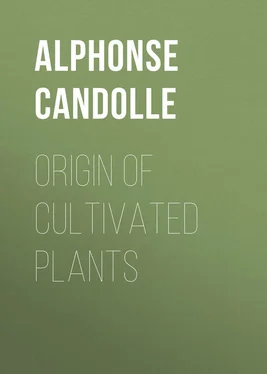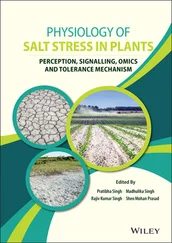Alphonse Candolle - Origin of Cultivated Plants
Здесь есть возможность читать онлайн «Alphonse Candolle - Origin of Cultivated Plants» — ознакомительный отрывок электронной книги совершенно бесплатно, а после прочтения отрывка купить полную версию. В некоторых случаях можно слушать аудио, скачать через торрент в формате fb2 и присутствует краткое содержание. Жанр: foreign_antique, foreign_prose, на английском языке. Описание произведения, (предисловие) а так же отзывы посетителей доступны на портале библиотеки ЛибКат.
- Название:Origin of Cultivated Plants
- Автор:
- Жанр:
- Год:неизвестен
- ISBN:нет данных
- Рейтинг книги:4 / 5. Голосов: 1
-
Избранное:Добавить в избранное
- Отзывы:
-
Ваша оценка:
- 80
- 1
- 2
- 3
- 4
- 5
Origin of Cultivated Plants: краткое содержание, описание и аннотация
Предлагаем к чтению аннотацию, описание, краткое содержание или предисловие (зависит от того, что написал сам автор книги «Origin of Cultivated Plants»). Если вы не нашли необходимую информацию о книге — напишите в комментариях, мы постараемся отыскать её.
Origin of Cultivated Plants — читать онлайн ознакомительный отрывок
Ниже представлен текст книги, разбитый по страницам. Система сохранения места последней прочитанной страницы, позволяет с удобством читать онлайн бесплатно книгу «Origin of Cultivated Plants», без необходимости каждый раз заново искать на чём Вы остановились. Поставьте закладку, и сможете в любой момент перейти на страницу, на которой закончили чтение.
Интервал:
Закладка:
5. Philology. The common names of cultivated plants are usually well known, and may afford indications touching the history of a species, but there are examples in which they are absurd, based upon errors, or vague and doubtful, and this involves a certain caution in their use.
I could quote a number of such names in all languages; it is enough to mention, in French, blé de Turquie , maize, a plant which is not a wheat, and which comes from America; in English, Jerusalem artichoke ( Helianthus tuberosus ), which does not come from Jerusalem, but from North America, and is no artichoke.
A number of names given to foreign plants by Europeans when they are settled in the colonies, express false or insignificant analogies. For instance, the New Zealand flax resembles the true flax as little as possible; it is merely that a textile substance is obtained from its leaves. The mahogany apple (cashew) of the French West India Isles is not an apple, nor even the fruit of a pomaceous tree, and has nothing to do with mahogany.
Sometimes the common names have changed, in passing from one language to another, in such a manner as to give a false or absurd meaning. Thus the tree of Judea of the French ( Cercis Siliquastrum ) has become the Judas tree in English. The fruit called by the Mexicans ahuaca , is become the avocat (lawyer) of the French colonists.
Not unfrequently names of plants have been taken by the same people at successive epochs or in different provinces, sometimes as generic, sometimes as specific names. The French word blé , for instance, may mean several species of the genus Triticum, and even of very different nutritious plants (maize and wheat), or a given species of wheat.
Several common names have been transferred from one plant to another through error or ignorance. Thus the confusion made by early travellers between the sweet potato ( Convolvulus Batatas ) and the potato ( Solanum tuberosum ) has caused the latter to be called potato in English and patatas in Spanish.
If modern, civilized peoples, who have great facilities for comparing species, learning their origin and verifying their names in books, have made such mistakes, it is probable that ancient nations have made many and more grave errors. Scholars display vast learning in explaining the philological origin of a name, or its modifications in derived languages, but they cannot discover popular errors or absurdities. It is left for botanists to discover and point them out. We may note, in passing, that the double or compound names are the most doubtful. They may consist of two mistakes; one in the root or principal name, the other in the addition or accessory name, destined almost always to indicate the geographical origin, some visible quality, or some comparison with other species. The shorter a name is, the better it merits consideration in questions of origin or antiquity; for it is by the succession of years, of the migrations of peoples, and of the transport of plants, that the addition of often erroneous epithets takes place. Similarly, in symbolic writing, like that of the Chinese and the Egyptians, unique and simple signs indicate long-known species, not imported from foreign countries, while complicated signs are doubtful or indicate a foreign origin. We must not forget, however, that the signs have often been rebuses, based on chance resemblances in the words, or on superstitious and fanciful ideas.
The identity of a common name for a given species in several languages may have two very different explanations. It may be because a plant has been spread by a people which has been dispersed and scattered. It may also result from the transmission of a plant from one people to another with the name it bore in its original home. The first case is that of the hemp, of which the name is similar, at least as to the root, in all the tongues derived from the primitive Aryan stock. The second is seen in the American name of tobacco, the Chinese of tea, which have spread into a number of countries, without any philological or ethnographic filiation. This case has occurred oftener in modern than in ancient times, because the rapidity of communications allows of the simultaneous introduction of a plant and of its name, even where the distance is great.
The diversity of names for the same species may also spring from various causes. As a rule, it indicates an early existence in different countries, but it may also arise from the mixture of races, or from names of varieties which take the place of the original name. Thus in England we find, according to the county, a Keltic, Saxon, Danish, or Latin name; and flax bears in Germany the names of flachs and lein , words which are evidently of different origin.
When we desire to make use of the common names to gather from them certain probabilities regarding the origin of species, it is necessary to consult dictionaries and the dissertations of philologists; but we must take into account the chances of error in these learned men, who, since they are neither cultivators nor botanists, may have made mistakes in the application of a name to a species.
The most considerable collection of common names is that of Nemnich, published in 1793. 18 18 Nemnich, Allgemeines polyglotten-Lexicon der Naturgeschichte , 2 vols. in 4to.
I have another in manuscript which is yet more complete, drawn up in our library by an old pupil of mine, Moritzi, by means of floras and of several books of travel written by botanists. There are, besides, dictionaries of the names of the species in given countries or in some special language. This kind of glossary does not often contain explanations of etymology; but in spite of what Hehn 19 19 Hehn, Kulturpflanzen und Hausthiere in ihren Uebergang aus Asien , in 8vo, 3rd edit. 1877.
may say, a naturalist possessed of an ordinary general education can recognize the connection or the fundamental differences between certain names in different languages, and need not confound modern with ancient languages. It is not necessary to be initiated into the mysteries of suffixes or affixes, of dentals and labials. No doubt the researches of a philologist into etymologies are more profound and valuable, but this is rarely necessary when our researches have to do with cultivated plants. Other sciences are more useful, especially that of botany; and philologists are more often deficient in these than naturalists are deficient in philology, for the very evident reason that more place is given to languages than to natural history in general education. It appears to me, moreover, that philologists, notably those who are occupied with Sanskrit, are always too eager to find the etymology of every name. They do not allow sufficiently for human stupidity, which has in all time given rise to absurd words, without any real basis, and derived only from error or superstition.
The filiation of modern European tongues is known to every one. That of ancient languages has, for more than half a century, been the object of important labours. Of these I cannot here give even a brief notice. It is sufficient to recall that all modern European languages are derived from the speech of the Western Aryans, who came from Asia, with the exception of Basque (derived from the Iberian language), Finnish, Turkish, and Hungarian, into which, moreover, words of Aryan origin have been introduced. On the other hand, several modern languages of India, Ceylon, and Java, are derived from the Sanskrit of the Eastern Aryans, who left Central Asia after the Western Aryans. It is supposed, with sufficient probability, that the first Western Aryans came into Europe 2500 B.C., and the Eastern Aryans into India a thousand years later.
Basque (or Iberian), the speech of the Guanchos of the Canary Isles, of which a few plant names are known, and Berber, are probably connected with the ancient tongues of the north of Africa.
Читать дальшеИнтервал:
Закладка:
Похожие книги на «Origin of Cultivated Plants»
Представляем Вашему вниманию похожие книги на «Origin of Cultivated Plants» списком для выбора. Мы отобрали схожую по названию и смыслу литературу в надежде предоставить читателям больше вариантов отыскать новые, интересные, ещё непрочитанные произведения.
Обсуждение, отзывы о книге «Origin of Cultivated Plants» и просто собственные мнения читателей. Оставьте ваши комментарии, напишите, что Вы думаете о произведении, его смысле или главных героях. Укажите что конкретно понравилось, а что нет, и почему Вы так считаете.











